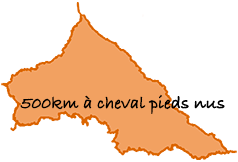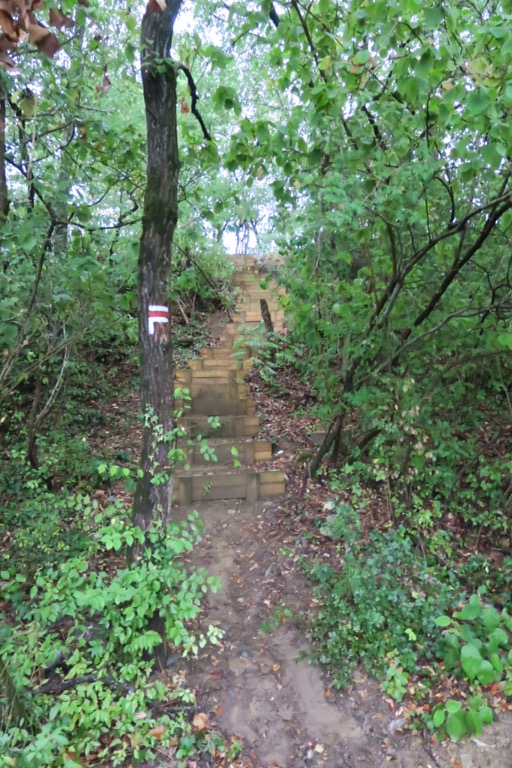As forecast, the rain arrived in the early hours of the morning and we awoke to the prospect of dismantling the tent and fencing and saddling up the horses in the rain. As luck would have it, when we actually came to carrying out these tasks, the rain had eased and, despite the tent and the horses being damp, we were able to break camp and set off without getting wet ourselves.
The day was marked by five river crossings -three times Garonne and twice the Arize- and our first real problems with the route.
At Carbonne, where Garonne is notably narrower than we are accustomed, the route diverges southwards to take in the ancient town of Rieux-Volvestre.
This was to be the first of many detours along the Via Garona -on reflection, not surprising since the route is part of the pilgrims’ route to Santiago de Compostela. It was also our first major encounter with an impasse:
a steep flight of steps ending at the edge of the road and protected by Armco – the horses may have climbed the steps, but the Armco would have defeated them. There was only one choice, to return to the road and go the long way around!
Shortly after lunch, a passing motorist stopped and offered advice where we could stay for the night -a kind gesture but one which came far too early in the day. Furthermore, his suggestion was a riding centre and knowing the variety of illnesses that can do the rounds at such establishments, we felt it wise to avoid them wherever possible. After our detour to Rieux-Volvestre, the route predictably descended back to Garonne and at Saint-Julien-sur-Garonne we found another bridge to shelter us for the night.
The following morning started with an exploration of the bridge structure built from three parallel box sections.
The departure was notable for an absence of clear markings. We had found our camp the evening before by ‘following’ the markers but now they had disappeared! A quick check of the GPS revealed we should actually cross the bridge and, with some imagination, the markers do show that, but only by scrabbling up a steep bank and jumping over yet another crash barrier! Once the other side, we were treated to a 500 metre tour of a housing estate to avoid a mere 80 metres of main road…something we would encounter more often in the coming days.
Finally, we joined one of the many canals which run parallel to Garonne, tapping her water to supply micro-hydroelectric power stations. These canals are actually quite dangerous since the banks are constructed of concrete at an angle of around 30º from vertical with the surface of the water some 5 to 10 metres below the top of the bank. The only way back out of the water is by one of the very occasional flight of rungs set into the concrete.
Finally, we arrived at Boussens only to find there that -once again- the route took us on a complete tour of the town only to emerge 20 metres from where we started! A search for a good spot to stop brought us too close to the motorway, so we retraced our steps and pitched camp at the side of the Lac de Boussens which, in fact, is not a lake but merely a very wide part of the Garonne

The next day took us on some winding paths with uncertain accessibility
to Saint-Martory with its splendid old 17th century bridge and gatehouses.
Following the main road, there are about 22 kilometres between Boussens and Saint-Gaudens. At the end of the day, having travelled some 29km, we descended upon Beauchalot, less than half way to Saint-Gaudens!!!
Even better than being beside the river (ideal water supply for the horses) is being beside a cemetery -there is (almost) always running water, there is often a piece of ground where the horses can graze and to pitch the tent, and the neighbours are very quiet… Except at Beauchalot, the main Toulouse-Pau railway line runs directly behind the cemetery. So we were very surprised when the late evening and night remained completely undisturbed by rail traffic. Morning dawned, and still no trains…apparently, a national strike from Monday evening until Wednesday morning!
A small evaluation of the horses’ feet at this stage of just over 100km: little change from when we left Fenouillet – if anything, they could be considered to be too long…
Having replaced the girth on the pack at Portet, we found we still had a problem with the blanket. It was clearly not giving enough protection to either Hévéa or Vermeil. Next stop, Equi-Sport at Estancarbon, 10km away but still more or less on our route. A new endurance pad was procured, along with a second-hand ‘shock-asbsorber’. Additionally, a new leather saddle bag was bought to (eventually) replace the synthetic Barefoot saddle bag which had already succumbed to much wear and tear among the trees on the way.
In the car park at the shopping centre, we were ‘accosted’ by a lady who, it turned out, knew Aurélie who had helped us at Equestra several days earlier.

Newly padded and sacked, we continued to Saint-Gaudens where we wrestled with the map (bought new but so old the ring road was not even marked as projected…) and finally found our way out towards Valentine and yet another stretch of canal feeding a number of micro-hydroelectric generating stations. There, in sight of, but sufficiently far from the papier-maché factory, we pitched camp.
Wednesday morning dawned magnificent.
Our route took us back to Garonne and towards Montréjeau. At Gourdan-Polignan we crossed the branch line from Montréjeau to Bagnère-de-Luchon and noted that at least one of the supports for the catenary was severely damaged and the line was clearly out of action. It used to be one of the lines served by the Night Train service from Paris Austerlitz – the only service now remaining being to Toulouse, the separating one part to Rodez and the other the Latour-de-Carol (more on that later).
Soon we were in site of the famous cathedral at Saint-Bertrand-de-Comminges, the destination for the Via Garona and our destination for the night – exactly seven days after our departure from Fenouillet.
















